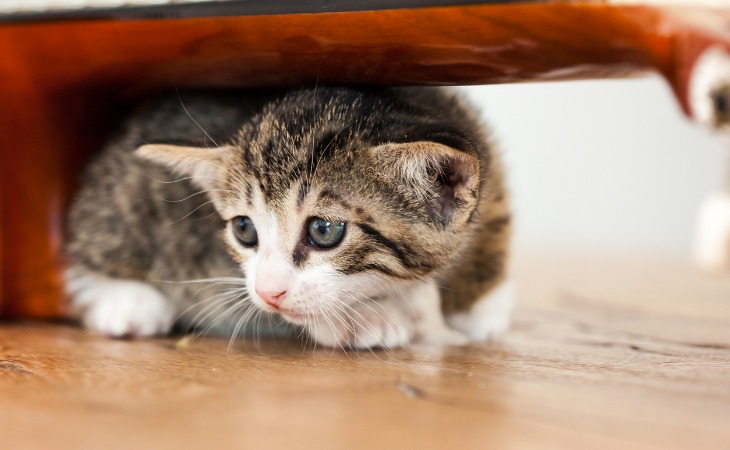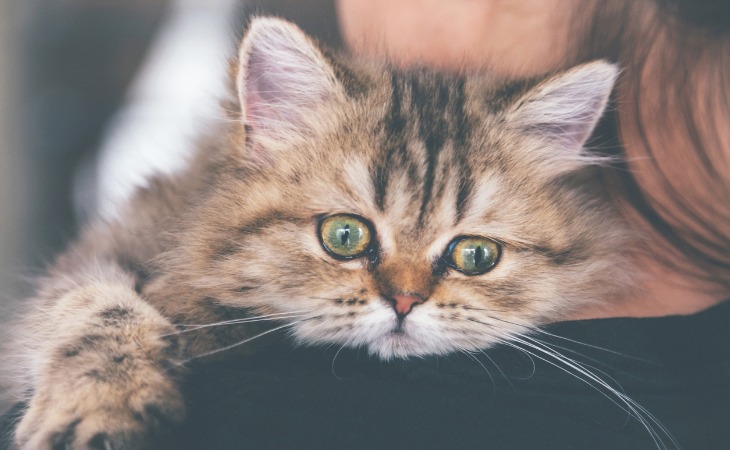While cats cannot talk like we do, they do make a wide variety of sounds. In fact, more than a hundred are referenced. However, it is not always easy for us humans to interpret them. For example, sometimes it’s hard to tell the difference between a crying cat and a meowing cat. When kittens are young, they learn to communicate with their mother through vocalizations and enrich their “vocabulary” over the years as they come in contact with humans and fellow cats.
Some of the sounds that cats make are used only with humans. Yet, you may be having a hard time figuring out what they are trying to tell you through their meowing. For example, how can you tell the difference between a crying cat and a meowing cat? We’ll help you understand the subtleties of your pet’s language by deciphering the most common sounds used in their daily communication.
You might also like this article: Why does my cat meow at night?
Why do cats cry?
Unlike humans, cats do not produce tears when they are sad. Instead, when their eyes are watering, it is usually an indication that their eyes are irritated or that they have a disease. One example of a condition that cats could have is called epiphora, which is an excessive and abnormal amount of tears.
Something is in their eye
If something has crept into your cat’s eye, their eyes will start to tear up to expel it. This could be caused by dust, hair, or even a blade of grass. If the tears are not enough to eliminate what is bothering them, it’s best to gently clean the irritated eye. You can do this with a sterile compress soaked in saline solution. That will help to remove the dirt. If after a few days, there is still no improvement, consult a veterinarian who can check whether or not there is an infection. Check your cat’s eyes regularly, especially if they spend a lot of time outdoors.
You might also like this article: Why does my cat get scabs?
Their tear ducts are blocked
If your cat’s eyes are tearing up because of an infection (viral or bacterial) or by an allergy, the blockage of the lacrimal canal will intensify if your cat does not receive the appropriate treatment. If you see purulent discharge coming out of your cat’s eyes, this is usually a sign of conjunctivitis. The color of these tears will be a bit yellowish. In addition, crust appears along their nose and their eyelids are sometimes swollen. Unfortunately, Persian cats are more often victims of tear duct obstructions. This is due to their small flattened muzzles. Feline breeds with a narrow tear duct are also at increased risk. Antibiotic drops prescribed by a veterinarian can help to heal contaminated eyes effectively and quickly.
An infectious or inflammatory disease
Other diseases and conditions are also associated with watery eyes. For instance, feline viral rhinotracheitis, which is often related to the human flu in its symptoms, is accompanied by a runny nose. If you notice that your cat is suffering from feline viral rhinotracheitis, do your best to control your pet’s fever and monitor their appetite.
Entropion is a condition that can cause an epiphora. This condition is characterized by the eyelid curling inwards and exacerbating discharge. This slight physiological abnormality generates abundant tears and can, in time, create an ulcer on the cornea. If this happens, surgery can be done to relieve their discomfort. Other diseases such as glaucoma or a tumor can also intensify the amount of tears that a cat lets out. Do not hesitate to consult a veterinarian at the slightest doubt and especially if it persists over time.
Plaintive sounds, signs of depression
A cat does not cry out of sadness. While they do feel emotions, they rarely express their unhappiness by whining. When a cat is sad, we can usually notice this by observing some unusual behaviors. For example, they may sulk in the bathroom, sleep more than usual or be reluctant to eat their favorite food. In addition, if they pull out their hair, scratch themselves, or their attitude changes radically, this is usually a sign of stress or anxiety.
A cat who spend a lot of time alone without any activities will become depressed. If you are comfortable with letting your cat ouside, you can let your cat have the possibility to leave your home easily when you are away. To do this, you can set up a cat flap or a cat door. Cats like to be able to keep their habits and maintain their daily routine. Moving or making big changes in your home will disturb him and can make them depressed. Changes in the family unit can also affect your pet. This might be a baby or the loss of a family member, for example.

What is my cat trying to say when they meow?
Your cat’s vocalizations reflect not only their state of mind and their emotions, but also their needs. Did you know that cats make a large variety of sounds and it differs from species to species? If you observe your cat enough, you will gradually start to recognize what they are trying to tell you through their meowing.
If your feline meows very often, it’s because you’re not responding to their requests. Unless, of course, your feline is particularly talkative to begin with. Just like humans, cats have their own personalities and ways of expressing themselves.
For the most part, domestic cats are more talkative than wild cats. Let’s take a look at some of the most common sounds that cats make.
A high-pitched coo
This is a pleasant sound, indicative of a happy animal. When cats make this sounds, they are not trying to imitate a bird. Instead, they are trying to make a friendly connection with another cat or establish a connection with you. For instance, your cat might make this high-pitched coo when you get home from work as a greeting. It’s their unique way of saying hello, asking you for a hug, or asking to play. In other words, this sound expresses their desire to socialize.
A long meow
This insistent sound represents an unmet demand. Usually, cats make this sounds when they are asking for food or water. They might also make a long meowing sound to indicate that they want to go out or to return home. In addition, if your cat meows like this while approaching the litter box, it could mean that they do not find it clean enough. You can try to understand what your cat is trying to communicate by observing where they are. This will help you better understand what your little one is asking for.
A low and loud meow
A cat who is meowing low and loud is expressing their disapproval. A deep, accentuated tone can also indicate anxiety or aggression. This noise should not be taken lightly and it’s best to be careful. This sound usually precedes a fight or a violent reaction. If your cat feels cornered, they may also bite or scratch.
Hoarse sounds and gurgling
Male cats usually make these kinds of noises during mating season. It’s both a signal to attract females and to alert other suitors. They make this sound for long periods of time. During this period, female cats meows repeatedly and abnormally. For instance, their calls amy seem plaintive. Females may also behave in an aggressive way and make high-pitched cries after mating, rather unpleasant for them.
A growl
If your cat growls, they are expressing their fear, their stress or their desire to be left alone. In other words, they are trying to drive away the undesirable, whether it be a cat, a human being, or another animal.
A jerky meow
Characteristic of a state of excitement, your cat shows its eagerness for a prey they found. Meowing like this can sound like teeth chattering. You’ll hear it more often while your pet is hunting. Cats may also do this when they are under and overwhelming amount of stress.
A high-pitched squeak
As kittens, they make these high-pitched squeaks to call their mother when they want something or when they are asking for help.
Now, you have a better understanding of cat sounds and you should be able to recognize if your cat is crying or meowing. It should be noted that this list is not exhaustive and that every cat is unique. By observing and listening to your cat, you will understand what they are trying to communicate. Pay attention to the tone, frequency, and intensity of the sounds your cat makes and also look at their body language. The more exaggerated the cry, the more their need is urgent or important.

